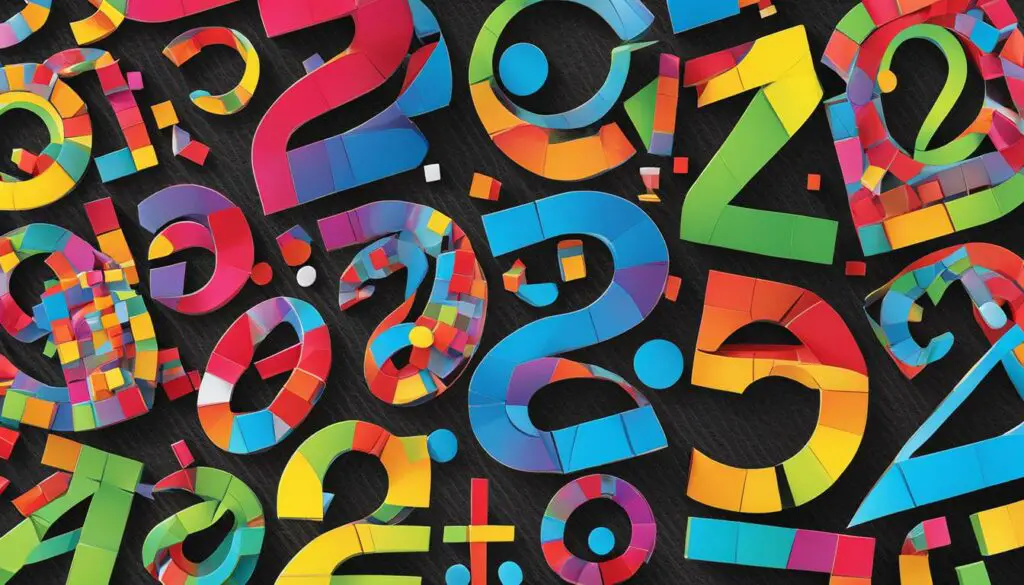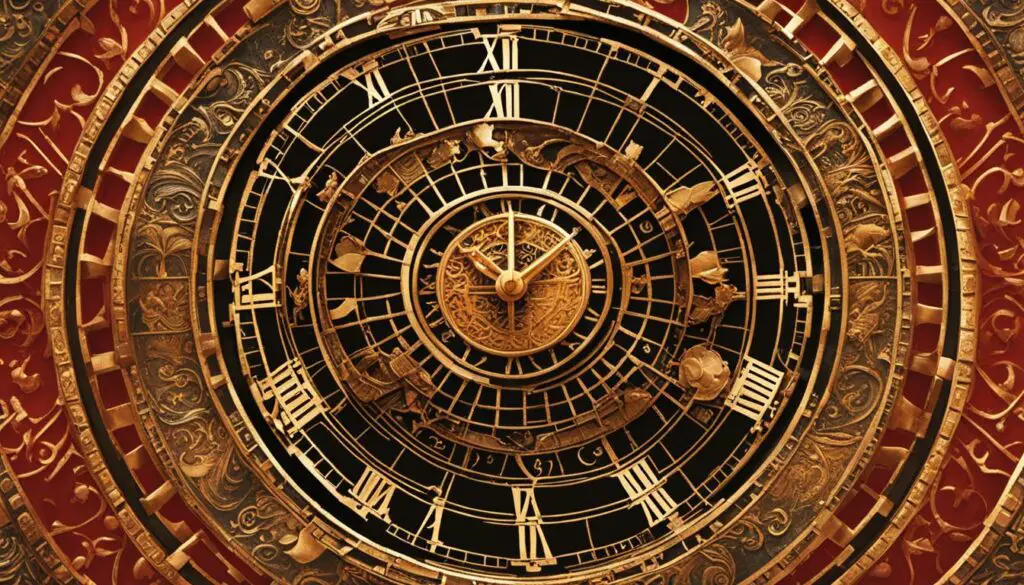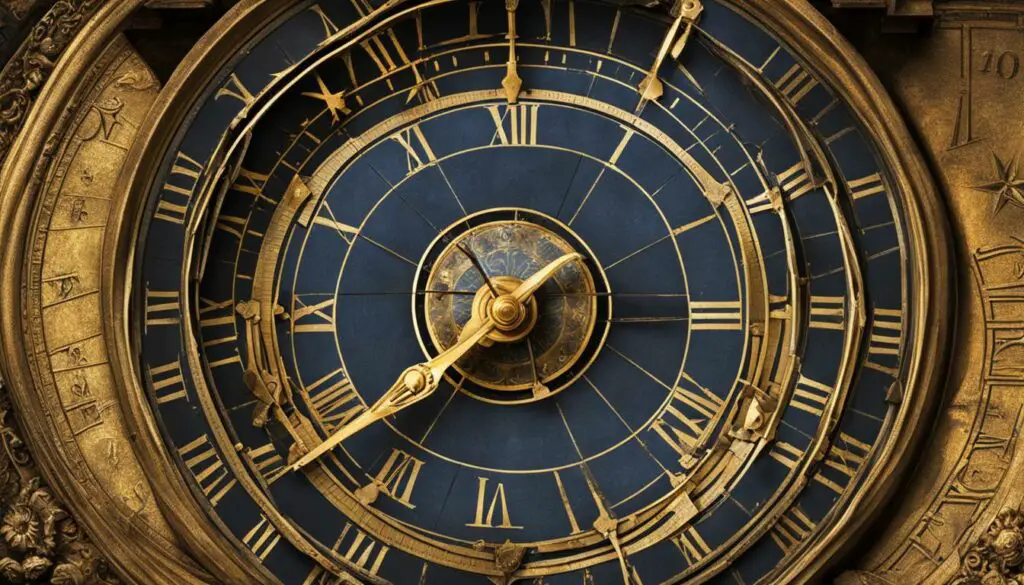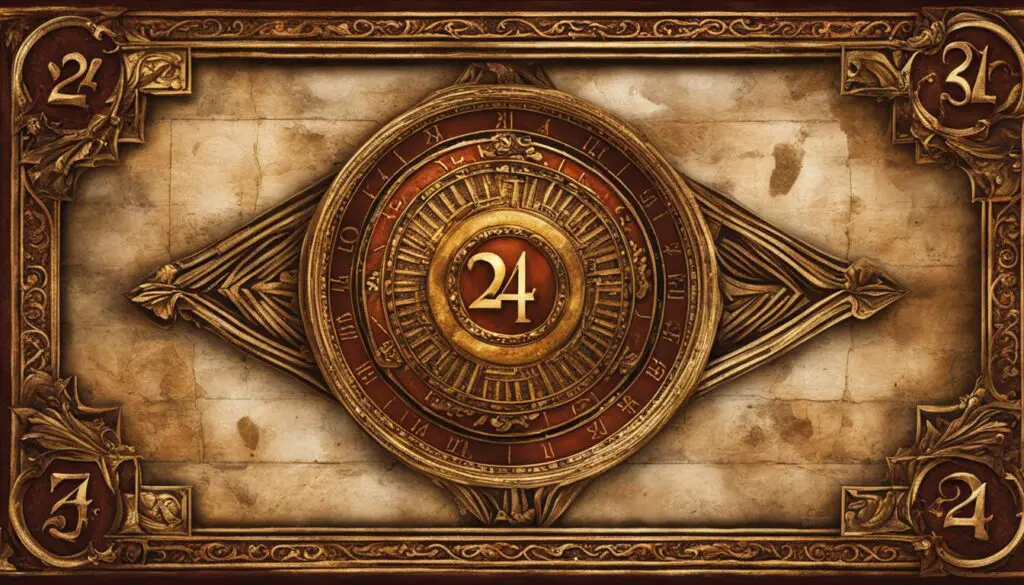Last Updated on October 30, 2023 by Francis
Have you ever stopped to consider the significance of the number 24? This seemingly ordinary number appears in various aspects of our lives, from time measurement to sports and games. However, there is more to 24 than meets the eye. In this article, we will explore the historical and cultural significance of 24, as well as its unique characteristics and symbolism. So, buckle up and get ready to discover the fascinating world of 24 the number!
Contents
Key Takeaways:
- 24 has a rich cultural and historical significance across various civilizations and belief systems.
- The number has unique mathematical and geometrical properties, including being a highly composite number.
- 24 is often associated with time measurement, including hours and days.
- It has also been used in literature, art, and popular culture, including referencing jersey numbers in sports.
- The significance of 24 continues to evolve in modern-day applications, including technology and business operations.
The Meaning and Symbolism of 24
The number 24 holds significant meaning and symbolism across cultures and belief systems. In numerology, 24 is often associated with harmony, balance, and creativity. It is believed to have a strong connection with the natural world, representing the four directions and the four seasons.
In many religions, 24 is considered a sacred number. In Hinduism, there are 24 incarnations of Lord Vishnu, while in Buddhism, it is said that the universe is divided into 24 sectors. In Christianity, 24 is associated with the 24 elders mentioned in the Book of Revelation.
“Twenty-four, the number of the elders, the number of complete cycles, the number of hours in a day and night of the Brahma gods, and the number of letters in Gayatri Mantra.” – Sathya Sai Baba
Throughout history, 24 has been used in various ways to represent completeness and perfection. In ancient Babylon, the year was divided into 12 months of 24 hours each. The ancient Egyptians had 24 deities, collectively known as the “company of the gods.”
The Chinese Zodiac and 24
In Chinese astrology, 24 is associated with the rat and the pig – two of the twelve animals in the Chinese zodiac. According to legend, the Jade Emperor held a race to determine the order of the zodiac animals, with the rat crossing the finish line first by hitching a ride on the pig’s back.

“You are only given a little spark of madness. You mustn’t lose it.” – Robin Williams
Overall, the number 24 holds a rich history and symbolism that has influenced human culture throughout the ages.
The Numerical Value of 24
The number 24 is a positive integer that represents a quantity or value in numerical systems. Its numeric representation is a combination of the digit 2 and 4, with a place value of tens and ones, respectively.
In mathematics, 24 is a highly composite number, meaning that it has numerous positive divisors or factors. Specifically, 24 has eight divisors: 1, 2, 3, 4, 6, 8, 12, and 24. This characteristic makes it useful in various mathematical and logical operations, including fractions, ratios, and probabilities.
The numeric value of 24 is also significant in other numerical systems, including time measurement and currency exchange rates. For instance, in the standard 24-hour clock, 24 represents midnight or the end of the day. Additionally, some currencies, such as the Indian rupee and Nepalese rupee, have banknotes with denominations of 24.
The Divisibility of 24
One of the unique properties of the number 24 is its divisibility. As mentioned earlier, 24 has eight positive divisors, which means it can be divided evenly by these numbers without any remainder.
The table below shows the divisors and the corresponding quotient when 24 is divided by each divisor.
| Divisor | Quotient |
|---|---|
| 1 | 24 |
| 2 | 12 |
| 3 | 8 |
| 4 | 6 |
| 6 | 4 |
| 8 | 3 |
| 12 | 2 |
| 24 | 1 |
As shown in the table, 24 is divisible by 1, 2, 3, 4, 6, 8, 12, and 24. This property makes it a useful number in various mathematical and scientific applications.
Overall, the numerical value of 24 is significant in various numerical systems, including mathematics, time measurement, and currency exchange. Its unique properties, such as its highly composite nature and divisibility, make it a useful number in various fields.

Historical Significance of the Number 24
The number 24 has played an essential role in various ancient civilizations, calendars, and timekeeping systems.
In ancient Egypt, the number 24 represented the number of gods and goddesses who ruled the universe. The Egyptians divided the day into 24 hours, with each hour represented by a different deity. The number 24 also played a crucial role in their calendar system, which consisted of 12 months of 30 days each, resulting in a 360-day year.
Similarly, the Sumerians, Babylonians, and Greeks also used the number 24 in their calendar systems. The Greeks had a 24-letter alphabet, and they believed that the gods lived on Mount Olympus, which had 24 peaks.
The number 24 also has significance in the Christian religion. The Book of Revelation mentions 24 elders seated on thrones around God’s throne. These elders represent the 12 tribes of Israel and the 12 apostles of Jesus.
The Twenty-Four Solar Terms
In China, the number 24 is associated with the “Twenty-Four Solar Terms,” which mark the changing of seasons. Each solar term lasts approximately 15 days, resulting in a 360-day year. The Twenty-Four Solar Terms were first recorded in the Warring States period (475-221 BCE), and they have been used ever since.
The Twenty-Four Solar Terms played a significant role in agriculture, as they determined when farmers should sow, irrigate, and harvest crops. The solar terms also influenced Chinese poetry, literature, and customs, as they were used to mark important dates and festivals.
The Number 24 in Numismatics
The number 24 has also been featured on numerous coins throughout history. For example, in ancient Rome, the denarius coin was divided into 24 smaller units called “semis.” Similarly, the British pound was divided into 20 shillings, with each shilling consisting of 12 pence, resulting in a total of 240 pence per pound.

The image above showcases an ancient Roman coin that features the number 24.
In conclusion, the number 24 has a rich and diverse historical significance, reflecting its prominence in various cultures and belief systems. From timekeeping to agriculture, numerology to religion, the number 24 has left an indelible mark on human civilization.
24 in Religion and Mythology
The number 24 holds a significant place in various religious and mythological contexts. In Christianity, there were 24 elders around the throne of God in the Book of Revelation. Similarly, in Islam, 24 prophets are mentioned in the Quran, and it is believed that there are 24 spiritual leaders (Imams) in the Shia branch of Islam.
Additionally, the number 24 has been associated with deities and rituals in ancient mythology. For example, in Greek mythology, the hours of the day were divided into 24 parts, with each hour represented by a different deity or nymph. The Mayan calendar consists of 18 months with 20 days each, totaling 360 days. To complete the calendar year, they added five extra days, making it a 365-day year. Interestingly, 24 hours in a day multiplied by 15 days in a Mayan month equals 360.
“There are 24 spiritual leaders (Imams) in the Shia branch of Islam.”
Similarly, in Hindu mythology, the chakras (energy centers in the body) are associated with 24 petals, each corresponding to a specific aspect of human consciousness and existence. These chakras are believed to be the key to unlocking the body’s spiritual potential.
Overall, the number 24 plays a significant role in various religious and mythological belief systems, representing spiritual leaders, deities, and symbolic divisions of time.

24 as a Mathematical and Geometrical Concept
As a digit, the number 24 has numerous mathematical properties and applications. It is an even composite number, composed of two squared numbers, making it a highly composite number. It is divisible by 1, 2, 3, 4, 6, 8, 12, and 24, granting it eight divisors in total.
Furthermore, 24 is the factorial of 4, which means that it is capable of arranging four distinct objects in 24 different ways. This concept is well-known in combinatorial mathematics and has various applications in fields such as probability theory and network optimization.

24 also appears in various geometrical systems, being the number of vertices in both a truncated octahedron and an octo-dodecahedron. It is also the number of classical hour angles in a complete rotation of the earth, which is the basis of the division of the day into 24 hours.
In music theory, 24 is the number of major and minor keys in Western tonal music, with each key having a unique tonal center and harmonic structure. In astrology, 24 is linked to the number of hours in a day, with each hour representing a different zodiac sign.
24 in Literature and Art
The number 24 has been a recurring motif in literature and art, often symbolizing completeness or a sense of closure. In William Shakespeare’s play, “The Tempest,” there are 24 hours in which the events of the play take place, emphasizing the fleeting nature of time. Similarly, in J.R.R. Tolkien’s “The Lord of the Rings” trilogy, there are 24 members of the Fellowship of the Ring, representing a complete group of companions.
In terms of art, Belgian surrealist painter René Magritte created a painting titled “The Twenty-four Hour Clock” in 1957. The painting depicts a clock with an image of a bird in a cage replacing the clock’s hands, perhaps alluding to the idea that time can be a limiting factor.

“The very first time I saw the number 24 was when I was six years old. My dad had a basketball jersey with the 24 on it, and I said, ‘I want to be just like him,’ – Kobe Bryant
Even famous artists like Kobe Bryant have acknowledged the power of the number 24. His NBA career was defined by his jersey number 24, which he wore for more than a decade.
Cultural References to 24
The number 24 has made numerous appearances in popular culture, from music to movies and television shows. One of the most famous cultural references to 24 is the popular TV series, “24,” which starred Kiefer Sutherland as counterterrorism agent Jack Bauer. The show ran for eight seasons from 2001 to 2010 and was known for its real-time format, with each season comprising 24 episodes, each representing an hour in a single day.
In music, the number 24 has been referenced in several popular songs. For example, Beyoncé’s album “4” (2011) features a track titled “4” that references the significance of the number in her life. The song’s lyrics state, “We found the truth in a hopeless place / It’s like our time is racing, but I’m still the same / And I still love you just the same / But don’t you know I love you?” Other musical references to 24 include the song “24 Hours” by Joy Division and “24k Magic” by Bruno Mars.

Aside from movies and music, 24 is also referenced in other aspects of popular culture, such as sports. In the NBA, the number 24 is famously associated with Kobe Bryant, who wore the number throughout his career with the Los Angeles Lakers. Bryant’s legacy has made the number 24 a symbol of perseverance and dedication to basketball fans worldwide.
Moreover, in literature, the number 24 has been used as a symbol of completeness and wholeness. In the Bible, the book of Revelations refers to the 24 elders who surround the throne of God in heaven, representing the completeness of the people of God. The number also appears in the works of Shakespeare, with Hamlet famously declaring, “There are more things in heaven and earth, Horatio, / Than are dreamt of in your philosophy. But come, / Here, as before, never, so help you mercy, / How strange or odd soe’er I bear myself / As I, perchance, hereafter shall think meet / To put an antic disposition on— / That you, at such times seeing me, never shall, / With arms encumber’d thus, or this head-shake, / Or by pronouncing of some doubtful phrase, / As ‘Well, well, we know,’ or ‘We could, an if we would,’ / Or ‘If we list to speak,’ or ‘There be, an if they might,’ / Or such ambiguous giving-out, to note / That you know aught of me: this not to do, / So grace and mercy at your most need help you, Swear.”
24 and Time Measurement
The number 24 has a significant role in time measurement. It represents the number of hours in a day, which is divided into two cycles of 12 hours each. This system has been used for centuries across many cultures and remains the standard measurement of time in our modern society.
Moreover, the number 24 is also essential in measuring longer time periods. It represents the number of hours in a full day, but it is also the number of hours in half of a day, also known as “half-day” or “noon.”
Additionally, the number 24 is an integral part of the Julian and Gregorian calendars, which are the most commonly used calendars worldwide today. In these calendars, a month is divided into two halves, each having 15 days, which adds up to 30 days for the whole month. However, some months have 31 days, and February has 28 or 29 days. A year is then divided into 12 months, resulting in 365 or 366 days per year.
The 24-Hour Clock
The 24-hour clock, also known as military time, uses the number 24 to represent the hours of the day. This system eliminates the need for the “a.m.” and “p.m.” designations used in the 12-hour clock system. For example, instead of saying “3 p.m.,” the 24-hour clock uses the notation “1500 hours.”
The 24-hour clock is commonly used in countries such as the United States, Canada, and Australia, especially in healthcare and military contexts. It is also widely used in Europe and other parts of the world, particularly in transportation and international business operations.
24 and Time Zones
The world is divided into 24 time zones, each representing an hour of the day. Each time zone is approximately 15 degrees of longitude wide, starting from the Prime Meridian at Greenwich, England, and moving east and west. The time zones are labeled from UTC-12 to UTC+12, with UTC standing for Coordinated Universal Time.
The number 24 plays a crucial role in the concept of time zones and the coordination of time across the globe. It enables us to synchronize time and coordinate activities across borders, making international communication and commerce possible.

“Time and tide wait for no man.” – Geoffrey Chaucer
24 in Sports and Games
As a digit, 24 has been associated with numerous sports and games, often used as a jersey number or as part of the game’s scoring system. Basketball superstar Kobe Bryant, for example, wore the number 24 during the latter half of his career, earning numerous accolades and championships.
In racing, the number 24 holds a special significance, as it was the number of legendary NASCAR driver Jeff Gordon’s car. Gordon won 93 races and four Cup championships throughout his career, solidifying his status as one of the greatest drivers of all time.
Furthermore, 24 is a common number in certain sports’ timing systems, such as in professional golf where the standard pace of play is to complete a round in four hours and 24 minutes. In addition, some games, such as Backgammon, utilize 24 as a math symbol, representing the highest possible roll of the two dice.
Overall, the number 24 has played a significant role in various sports and games, both as a digit and as a math symbol, highlighting its versatile nature and widespread cultural importance.

Modern-Day Applications of 24
The number 24 has found a plethora of modern-day applications across various industries. Let’s take a look at some of the most significant ones:
Logistics and Transportation
In logistics and transportation, 24-hour services are essential to ensure efficient and timely delivery of goods and services. With the world becoming increasingly interconnected, the need for 24-hour services has only increased with time. Companies that offer 24-hour logistics services, such as UPS and FedEx, have become household names and have revolutionized the industry.
Business Operations
The number 24 is also important in business operations, especially in terms of managing time and resources effectively. Many companies operate on a 24-hour basis, with employees working in shifts around the clock. This has become increasingly common in the healthcare industry, where hospitals need to be staffed continuously to provide prompt medical care to patients.
Technology
Technology is another area where the number 24 has significant applications. For instance, there are 24 bits in an IPv4 internet protocol address, which is essential for transferring data packets across the internet. Additionally, many software applications require 24/7 uptime, which is facilitated by the use of cloud computing technology.
Sports and Entertainment
The number 24 has also gained popularity in sports and entertainment, especially in jersey numbers. The late basketball player Kobe Bryant famously wore the number 24 during his career with the Los Angeles Lakers, and the number has become synonymous with his legacy. Similarly, in NASCAR racing, the number 24 is associated with racing legend Jeff Gordon, who won four championships driving car number 24.

The number 24 has truly become a part of our daily lives, both historically and in modern times. From timekeeping and calendars to technology and business operations, its significance cannot be overstated.
Conclusion
Through our exploration of the number 24, we have discovered its fascinating history and remarkable significance in various aspects of human culture and society. From ancient civilizations and timekeeping systems to religion, literature, art, and modern-day applications, the number 24 has left a lasting imprint on our world.
As a numeric symbol, 24 carries both mathematical and geometrical significance, representing factors such as two and three, and forming a perfect square. Moreover, its connection to time measurement is undeniable, as it represents a full day comprising 24 hours.
Beyond its numerical value, the number 24 holds deep symbolic meanings across different cultures and belief systems. It has been associated with various deities, rituals, and sacred texts, as well as being referenced in literature and art.
Furthermore, 24 has been incorporated into popular culture and sports, such as being used as a jersey number, game duration, and scoring system. Its importance in modern-day applications, such as technology and business operations, should not be overlooked either.
As we conclude our exploration of the number 24, it is clear that it holds a special place in human history and culture. Its diverse meanings and symbolic power have stood the test of time, and continue to shape the way we observe and interact with the world around us.
FAQ
What is the significance of the number 24?
The number 24 holds various symbolic meanings across different cultures and belief systems. It represents completeness, harmony, and balance.
How has the number 24 been used throughout history?
The number 24 has been significant in ancient civilizations, calendars, and timekeeping systems. It has often been associated with the division of the day into 24 hours.
What is the numerical value of 24?
In mathematics, 24 is a whole number that comes after 23 and is followed by 25. It is commonly represented as “twenty-four” or with the numeral “24”.
How is the number 24 represented geometrically?
Geometrically, the number 24 can be visualized as a rectangular shape with 24 equal sides or as a circle divided into 24 equal sectors.
What are some cultural references to the number 24?
The number 24 has been referenced in various forms of popular culture, such as movies, music, and idioms. It often represents a complete set or a significant quantity.
How is the number 24 connected to time measurement?
The number 24 is closely related to the concept of time measurement. It represents 24 hours in a day and is used in systems like the 24-hour clock and the division of the day into two 12-hour periods.
What is the significance of the number 24 in sports and games?
In sports and games, the number 24 is often associated with jersey numbers, game durations, or scoring systems. It is prominently used in basketball, where it was worn by famous players like Kobe Bryant.
How is the number 24 utilized in modern-day applications?
The number 24 finds applications in various modern-day fields, such as technology, logistics, and business operations. It may be used to represent deadlines, cycles, or numerical values in these contexts.






